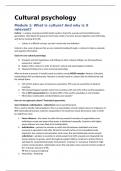Summary
Summary ALL cultural psychology exam material
- Course
- Institution
- Book
This is a summary of all the exam material in the subject of cultural psychology. This course will be taught in English and your exam will also be entirely in English. That is why this summary has been written in English, because you will also need to know all the terms in English. However, it is w...
[Show more]



